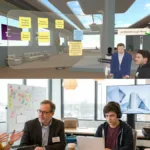Flowing as it does from the highlands of Mount Gede, the once clean and beautiful Ciliwung River in Jakarta, Indonesia was used not just for transportation and irrigation of crops, but even for drinking.
It still is, because the more than 25,000 poor families of Jakarta living along the Ciliwung River (and the 12 other rivers which form a confluence in Jakarta) can’t afford water delivery. ut where once people drank directly from the river, the last two decades of population growth and industrial development means they must now boil the water thoroughly.

Even that is not always enough to prevent water-borne illnesses like diarrhea and premature death, and these are the problems the Ciliwung Recovery Program concept design, or CRP – a 2010 eVolo Skyscraper Competition second place winner – is designed to address via the use of mega-filters. And by mega we mean apartment building-sized.
The filters themselves look like nothing so much as giant mottled green and white building blocks hastily scattered by a child. Appearances aside, the blocks, or units, operate in three separate phases. In the first, they sort the refuse into biodegradable substances (which can be used to fertilize the soil) and inert compounds (like plastic and metal) which can be recycled or disposed of in an appropriate landfill.
The second phase of the CRP purifies the water by filtering out dangerous chemicals and adding essential minerals. This cleaned water is then fed back into the river for use on nearby crops (through a system of capillaries very much like those in the human body). With this second phase, poor Jakartans living along the river will be resettled into living units in the CRP building, opening up spaces which can be used to remediate the flood plain or create green recreational spaces.
In the final phase, with all the waste processed and the capillary irrigation connected to generator towers, some of the purified water is sprayed from the upper floors of buildings, creating a moist atmosphere in which to nurture pioneer plants for a new ecosystem.
But, designers hasten to add, the most important aspect of their design is to remove slums along the river and re-establish families in 100-percent sustainable buildings producing their own energy through wind, solar and hydroelectric systems, very much like the sustainable city on water we reported on in March.






